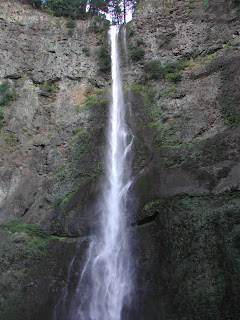Warning: Technical sailing and navigating info!
When I started "messing" around in boats over 40 years ago, we did not have much to navigate with. My early boats had a compass and I carried paper charts and simple parallel rules and dividers for plotting courses. I cruised with these basic items and even crossed the Strait of Juan de Fuca in dense fog several times. It was the way we did things then. If anything I became good at plotting my course and finding my way in inclement weather and at night.
It was not until I bought my 30 foot sailboat "Good News" in 1977 did I start installing more navigation equipment. In addition to a compass, I now had a knotmeter to indicate how fast I was going and a depth sounder. The depth sounders of that era were referred to as "flashers". The unit had a disc rotated by an electric motor. On the disc was a neon light that would flash along a scale to indicate the depth. My depth sounder was a 0-100 foot unit, but if conditions were good, the flashing light could go around the dial multiple times. I once saw it go around six times indicating 600 feet.
As time went on and electronics became cheaper and more compact. I bought my first VHF radio around 1980. This allowed me to call for help, communicate with other boats and shore stations and monitor weather broadcasts. About this time I also bought a radio direction finder. This was a receiver with a rotating antenna. You could use this to receive a bearing to dedicated navigational beacons or commercial radio stations. The ideal was to get three bearings and plot them on a chart to indicate the boats position. In reality we often were happy with a single bearing line as a second opinion of our already predicted position.
By the mid 1980's, LORAN-C became popular. LORAN stood for Long Range Aid to Navigation. LORAN had been around since World War II and was mainly a aircraft navigation system. The "C" version was developed in the mid 1950's. LORAN uses shore radio transmitters with a "master" station and several "slave" stations. With the signals from the stations, the receivers derived a set of numbers referred to as TD's or time delays. Charts were overprinted with lines of TD's and where the TD's cross was the position of the vessel. Somewhat cumbersome, but as time went on and thanks to modern microprocessors, the LORAN-C receivers would derive the TD's to Latitude and Longitude. In addition, the receivers could also provide navigation and steering information such as: SOG(speed over ground), COG(course over ground), BTW(bearing to waypoint), DTW(distance to waypoint) and CTE(cross track error). Most units would only display "numbers", but more sophisticated, very expensive units were chartplotters and could display the position directly on a digital chart.
I purchased a Sitex LORAN unit in 1987. I liked it. After inputting waypoints to go to, it would direct me very accurately. I travelled many miles in foggy conditions, across open water and at night and always found my to my destination. Some strange things could occur with LORAN. Since the signal was a ground wave, in narrow mountainous areas, the signal was disrupted and I sometimes received strange results. Also LORAN only functioned about 200 miles offshore and some areas like south east Alaska had spotty coverage.
But LORAN soon was overtaken by GPS(Global Position System). As the name implies GPS works all over the globe. It receives signals from a constellation of satellites in synchronous orbit. I bough a Magellan handheld unit in the mid 1990's and later a Garmin mounted unit. These units were just "number" units like my LORAN and produced similar outputs as the LORAN. I still liked the LORAN and used it the most.
In 1999, I bought "Great White". Shortly after I bought "Great White", I purchased a Garmin 180 chartplotter. Now this was a big improvement! Even though it was a black/grey screen, it provided enough information to be able to navigate some with it. I slaved the GPS to the autopilot and it could steer to a waypoint better than I could. Later I bought a Garmin 182C chartplotter. The "C" stood for color. Now I had something that was easier to look at! I also started sending the output from the GPS to a laptop with a simple navigation program installed.
I first heard about AIS about 1994. AIS stands for Automatic Identification System. This is a system that transmits a vessels identification, speed, course and characteristics over the VHF radio. The AIS transponder receives its data from the GPS. Commercial vessels and ships are required to have an AIS. The other part of the AIS is a receiver. The receiver can either display the data it receives or send the data to a compatible display, GPS chartplotter or computer chartplotter program. In addition, the receiver can calculate the CPA (closest point of approach) and TCPA (time of closest point of approach) between the two vessels. A lot of AIS systems are still very expensive. A few years ago a spirited debate started on the sailing forums about the use of AIS. Some newer sailors were vocal about it being essential for safety and others like myself that felt that it was a "nice to have" that would have to wait until other expensive upgrades were completed. Also, my chartplotter was too old to support AIS. So I would have to come up with a new GPS or chartplotter software.
But last year at the boat show, I found a VHF radio that had an installed AIS receiver. Very cool and not too expensive. I was looking for a better VHF radio anyway. This radio had a small display that would show the CPA and TCPA from the approaching vessel. It is hard to read the numbers on the small display, but it was better than nothing. An alarm can be set to warn of close encounters. It has been useful already.
A few weeks ago a neighboring boater gave me a Garmin 498 Chartplotter. He could not get it to acquire satellites. I did not hold out much hope that it would work for me and sure enough, it would not acquire satellites with my antenna either. So I did some research and found that it could be reset. So I reset the system and it worked! This GPS is newer than my existing Garmin and it appeared that it was AIS compatible. So, I started investigating how to use it. First I found that it only had one "port". That meant that it could not send data at one baud rate and receive AIS info at another high speed baud rate. I could get a multiplexer that might make it work, but again that was expensive. So I thought that maybe I could use it only for an AIS receiver. I would still need an antenna for it. I finally gave up for the moment.
I then started looking into a new chartplotter software for the laptop. On the Van Isle Race last summer, the navigator was using a program called Open CPN(chartplotter navigator). This is a free navigating/charting program. And it is compatible with AIS. So I downloaded it, installed it on the nav laptop and started using it. I stumbled around and determined that it would do most of what I wanted. I then bought a couple of serial to USB converters, a hub and a serial cable and wired it up to the AIS. It worked! I had to mess with some configurations, but after after a few hours of experience with it, it seems stable and I have figured out the operation.
So, now that I have a graphical display of AIS info on the computer screen, how will I use it? After the newness wears off, I can see myself using it for a double check of crossing vessels. I usually check crossing vessels by taking bearings. In inclement weather and at night, I can see that it could work well to check for who is around. But I know that it is not the tell all. Already I can see targets disappear at times. Also could be used in racing. One of my competitors has a transponder. If he continues to use it, I can plot him and tell if he is getting closer! Wouldn't that be cool!
Here are a couple of websites that track vessel positions with AIS:
http://marinetraffic.com/ais/
http://ais3.siitech.com/VTSLite/AView.aspx
A screen shot of Open CPN with the AIS function turned on and an example of the AIS screens available. The yellow targets are "unknowns". These have info on course, speed, CPA and TCPA but do not identify the vessel. Green targets contain information on the vessel. Red targets have CPA's that fall within the CPA range I have set for alerting for an approaching vessel. A list of target information can called up as well as individual vessel info that can be obtained by placing the cursor over a target. The ferry "Walla Walla" is passing through Rich Passage. It's course passes close to my position even though it is a few miles away. The yellow square near its location gives it's basic info and the CPA and TCPA. The "AIS Target Query" shows the full data on the "Walla Walla" and the "AIS Target List" lists all the AIS target within the range I set(21 miles).


















